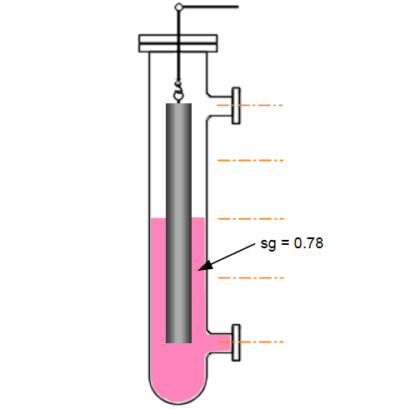Problem 1 :-

true weight of displacer = 0.25 × 490 = 122.5 lbs
volume of oil displaced = 0.25 × 0.5 = 0.125 cubic feet
weight of oil displaced = (0.125 × 0.78 × 63) lbs = 6.143 lbs
∴ Apparent weight of displacer = true weight − displaced weight
Apparent weight of displacer = 122.5 − 6.143 lbs = 116.36 lbs
Problem 2 :-
true weight of displacer = 0.1 × 490 lbs = 49 lbs
volume of water displaced = 0.1 cubic feet
weight of water displaced = 0.1 × 63 lbs = 6.3 lbs
∴ min. weight of the displacer = 49 − 6.3 lbs = 42.7 lbs
∴ max. weight of the displacer = 49 lbs
volume of the sensor = πr2L
Note : π = 3.142, 1 in = 1/12 ft = 0.0833ft
volume of the sensor ⇒ 0.1 ft3 = 3.142 × (0.0833)2 × L
0.1 ft3 = 0.0218 × L
hence, the length of displacer, L = 0.1 / 0.0218 = 4.587 ft , or 55 inches
Problem 3 :-
The displacer is assumed to be totally covered with oil or water.
volume of the sensor = πr2L
1000 c.c.s = 3.142 × r2 × 100 cm
thus, we now have, r2 = 1000 / (3.142 x 100 ) = 3.183 cm2
∴ the radius of displacer, r = Sqrt (3.183) cm = 1.78 cm
hence, the diameter of displacer = 1.78 × 2 cm = 3.56 cm
displacer’s weight in air = density × volume
Note that volume unit has to be inconsistent with density unit 1 ccs = 10−6 m3
= 8000 kgm−3 × (1×103/106) m3 = 8.0 kg
displacer’s weight in oil = (weight in air) − (weight loss in oil)
= 8.0 – (0.5 × 1 × 0.78) kg = 7.61 kg
displacer’s weight in water = (weight in air) − (weight loss in water)
= 8.0 – (0.5 × 1 × 1) kg = 7.50 kg
at 0% interface level, the displacer’s length will be covered 25% with water and 75% with oil. Hence, the displacer’s total weight will be made up of 75% of its weight in oil and 25% weight in water;
∴ displacer weight at 0% = (0.75 × 7.61) + (0.25 × 7.5) = 7.582 kg
at 50%, the displacer’s total weight will be made up of 50% weight in water, and 50% weight in oil;
∴ displacer weight at 50% = (0.5 × 7.61) + (0.5 × 7.5) = 7.555 kg
at 100%, the displacer’s total weight will be made up of 75% weight in water, and 25% weight in oil;
∴ displacer weight at 50% = (0.25 × 7.61) + (0.75 × 7.5) = 7.527 kg
Article Source : N. Asyiddin
Conductive Level Switch Principle
Ultrasonic Level Switch Principle
Level Measurement with wet leg
DP Level Transmitter Calibration
Learn an example PLC program to control a pump based on level sensors using ladder…
In the PLC timer application for security camera recording, when motion is detected then camera…
In this example, we will learn batch mixing with PLC ladder logic program using timer…
This PLC example on manufacturing line assembly is an intermediate-level PLC program prepared for the…
In this article, you will learn the PLC programming example with pushbutton and motor control…
This article teaches how to convert Boolean logic to PLC programming ladder logic with the…
View Comments
in order to find weight loss in oil and weight loss in water, 0.78x1 and 1x1 are gives density of oil and water respectively. which is multiplied with 0.5. how you got 0.5? volume of oil/water displaced will be equal to the volume of the displacer which is equal to 1000ccc right? (when the displacer is in oil or water completely, the displaced fluid volume will be equivalent to the volume of the displacer. correct me if I'm wrong). instead of 1000ccc(=0.001 m3) how you got 0.5
Is this calculations are correct?
I want to calculate the weight of the displacer. I have 3 parameters only height of the displacer, the radius of the displacer, and the material of the displacer the height is 14 inches and the radius is 1.47 inches and the material of the displacer is Carbon steel.
To calculate the displacer weight I used the density of carbon steel which is 0.284 lb/in3 and multiplied it by the volume which is 94.99in^3 and I am getting a weight of 26.94lb is this the correct method to calculate the weight of the displacer? or there is an alternative way to calculate the weight of displacer accurately.
formula used Volume of displacer=pi*r^2*(Height)
Weight=Density*Volume